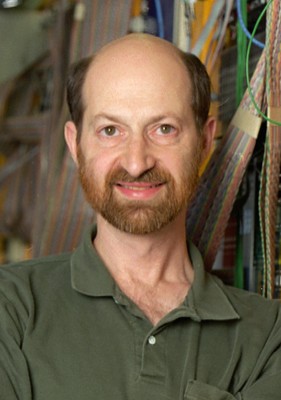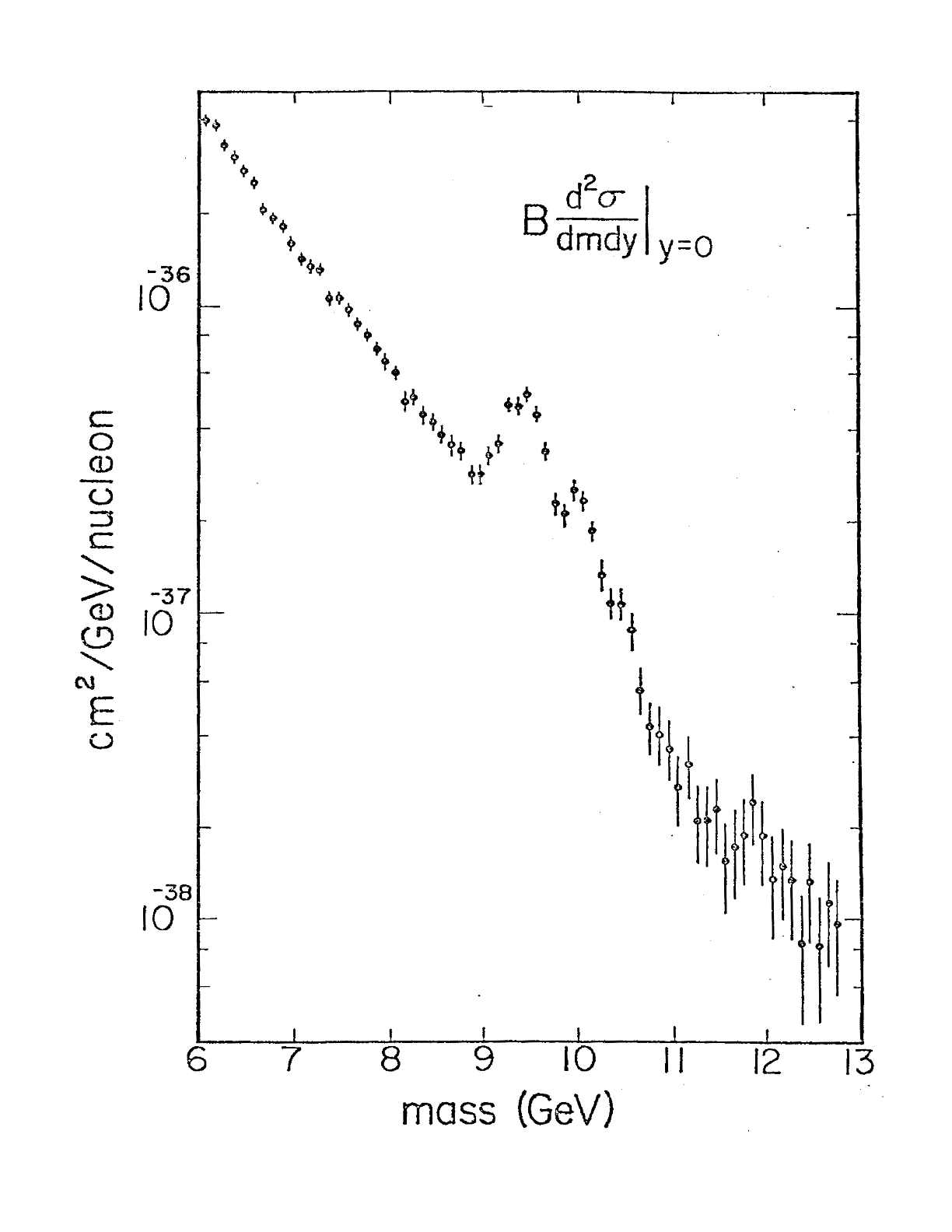How We Found the b Quark
IIT Department of Physics
 When I tell people about finding the b quark, I half expect them
to say, "I didn't even know it was missing!" That's what I would have said in
1975, when a small group of physicists from Columbia University, Fermilab, and
the State University of New York at Stony Brook began building new
subatomic-particle detectors that would lead to the b-quark's
discovery. At the time, I wasn't sure any quarks existed.
When I tell people about finding the b quark, I half expect them
to say, "I didn't even know it was missing!" That's what I would have said in
1975, when a small group of physicists from Columbia University, Fermilab, and
the State University of New York at Stony Brook began building new
subatomic-particle detectors that would lead to the b-quark's
discovery. At the time, I wasn't sure any quarks existed.
Until the fall of 1974, only three types of quarks were suspected. Many
physicists were unconvinced of their physical reality. Maybe the idea that
protons and neutrons were made of something smaller (whimsically called quarks
by Murray Gell-Mann in a reference to James Joyce's Finnegan's Wake)
reflected only some mathematical property of subatomic particles. This seemed
to be Gell-Mann's view when he first proposed the idea.
Then came the "November revolution": the simultaneous announcement by
groups at Stanford and Brookhaven National Laboratory of incontrovertible
evidence for a fourth type of quark. Harvard's Shelly Glashow had been
predicting the discovery for years, but few took him seriously. Perhaps it was
because he named his quark "charm."
At the time, Columbia's Leon
Lederman headed a group at the new National Accelerator Laboratory, now
known as Fermilab. He was investigating
exceedingly rare and little-understood processes that produce electrons and
positrons in proton-nucleus collisions. If an electron and a positron resulted
from the decay of a massive unstable particle, the mass of that "parent"
particle could be inferred from the momenta and angles of its "daughters."
Fresh from a year of graduate studies, I joined Lederman's group in 1975
along with a few of my Stony Brook professors. My first assignment was to help
a postdoc and technician build multiwire proportional chambers, the kind of
detector that had made the Brookhaven experiment so powerful. After I
accidentally cut some of the fine wires, I was pronounced "all thumbs" and
given a new assignment: programming the computer that supervised the experiment
and upgrading its software for the new detectors.
This was truly a high-stress job for a graduate student. We couldn't afford
to lose experimental data or valuable beam time through programming bugs. Yet
sitting in the trailer by myself struggling with the program until the sun came
up was a new and exciting experience! I quickly came to love the challenge and
the team's camaraderie. There we were, a dozen guys out on the prairie, driven
by a mission, keeping our high-tech toys together with duct tape and aluminum
foil.
Moreover, it was a complete democracy. It didn't matter whether you were a
callow graduate student or a senior professor. If you had a good idea, the
team would consider it. If you had a bad one, they would soundly denounce it.
Since Fermilab was the world's highest-energy particle accelerator, each
experimental run yielded unique results, published and widely scrutinized in
Physical Review Letters. But no breakthroughs yet.
By the spring of 1977, we had an experimental configuration that could take
1,000 times more data than our 1975 version. A key improvement was the switch
from detecting electrons and positrons to studying muons and antimuons. Muons
are "just like" electrons only 200 times heavier. They decay into electrons and
neutrinos in a couple of microseconds.
Since they are so massive, muons are little affected by the electric
charges inside matter. They can travel through many meters of iron with only
slight loss of energy, but are randomly scattered by occasional close
encounters with nuclei. Shielding could thus absorb most particles before they
entered our detectors, allowing us to run at higher beam intensity. We realized
that beryllium, though expensive and hard to work with, would be better than
iron since it would minimize scattering. Lederman scrounged enough
government-surplus beryllium to absorb most background particles, while leaving
the muons almost unscattered.
 After running a few weeks with the new configuration,
we found that the
probability for producing muon-antimuon pairs rose sharply in a narrow peak at
mass values around 10 times the proton mass. As more data accumulated, we
discerned multiple closely spaced peaks, smeared together from the muon
scattering. We were observing a new quark.
After running a few weeks with the new configuration,
we found that the
probability for producing muon-antimuon pairs rose sharply in a narrow peak at
mass values around 10 times the proton mass. As more data accumulated, we
discerned multiple closely spaced peaks, smeared together from the muon
scattering. We were observing a new quark.
We didn't get to name our quark. Theorists speculating about additional
quarks had already proposed two naming schemes for them. They were to be called
top and bottom, or truth and beauty. Strangely, both pairs of names have
stuck. With the discovery of top at Fermilab in 1995, the picture is now
complete.
Or is it? While the reactions producing b quarks occur in a tiny
fraction of a picosecond, it took us two years to observe them. Twenty years
later, b-quark decays may be the key to a fundamental problem
involving matter, antimatter, and the very existence of the material universe.
While matter and antimatter appear to be almost exact mirror images, the
universe as a whole seems to contain almost no antimatter. And a good thing,
too, since matter and antimatter annihilate into energy upon contact!
How could such an asymmetric universe have arisen if matter and antimatter
are mirror images? Shouldn't the Big Bang have produced equal amounts of each,
leading ultimately to a universe containing nothing but energy? How is it,
then, that stars, planets, and people exist at all?
Although we hardly imagined it at the time of their discovery,
b-quark decays show the largest matter-antimatter
asymmetry of any known phenomenon. But the expected effect is too small to
account for a universe made of matter. Sensitive
b-quark experiments are
in progress, and a new one is under construction.
Perhaps they will reveal a larger effect, arising from mechanisms as yet
unknown. Twenty years from now, my students may have the answer to the matter
of the universe.
(In 1997 we hosted the international symposium "Twenty Beautiful Years of Bottom
Physics" to commemorate the 1977 discovery of the b quark. During
3-1/2 days from June 29 to July 2, dozens of world-renowned experts were at
IIT to review the gamut of b-quark physics, from the b-quark
discovery experiment to the latest theoretical ideas and the new experiments
that will test them.)
 When I tell people about finding the b quark, I half expect them
to say, "I didn't even know it was missing!" That's what I would have said in
1975, when a small group of physicists from Columbia University, Fermilab, and
the State University of New York at Stony Brook began building new
subatomic-particle detectors that would lead to the b-quark's
discovery. At the time, I wasn't sure any quarks existed.
When I tell people about finding the b quark, I half expect them
to say, "I didn't even know it was missing!" That's what I would have said in
1975, when a small group of physicists from Columbia University, Fermilab, and
the State University of New York at Stony Brook began building new
subatomic-particle detectors that would lead to the b-quark's
discovery. At the time, I wasn't sure any quarks existed.
 After running a few weeks with the new configuration,
we found that the
probability for producing muon-antimuon pairs rose sharply in a narrow peak at
mass values around 10 times the proton mass. As more data accumulated, we
discerned multiple closely spaced peaks, smeared together from the muon
scattering. We were observing a new quark.
After running a few weeks with the new configuration,
we found that the
probability for producing muon-antimuon pairs rose sharply in a narrow peak at
mass values around 10 times the proton mass. As more data accumulated, we
discerned multiple closely spaced peaks, smeared together from the muon
scattering. We were observing a new quark.